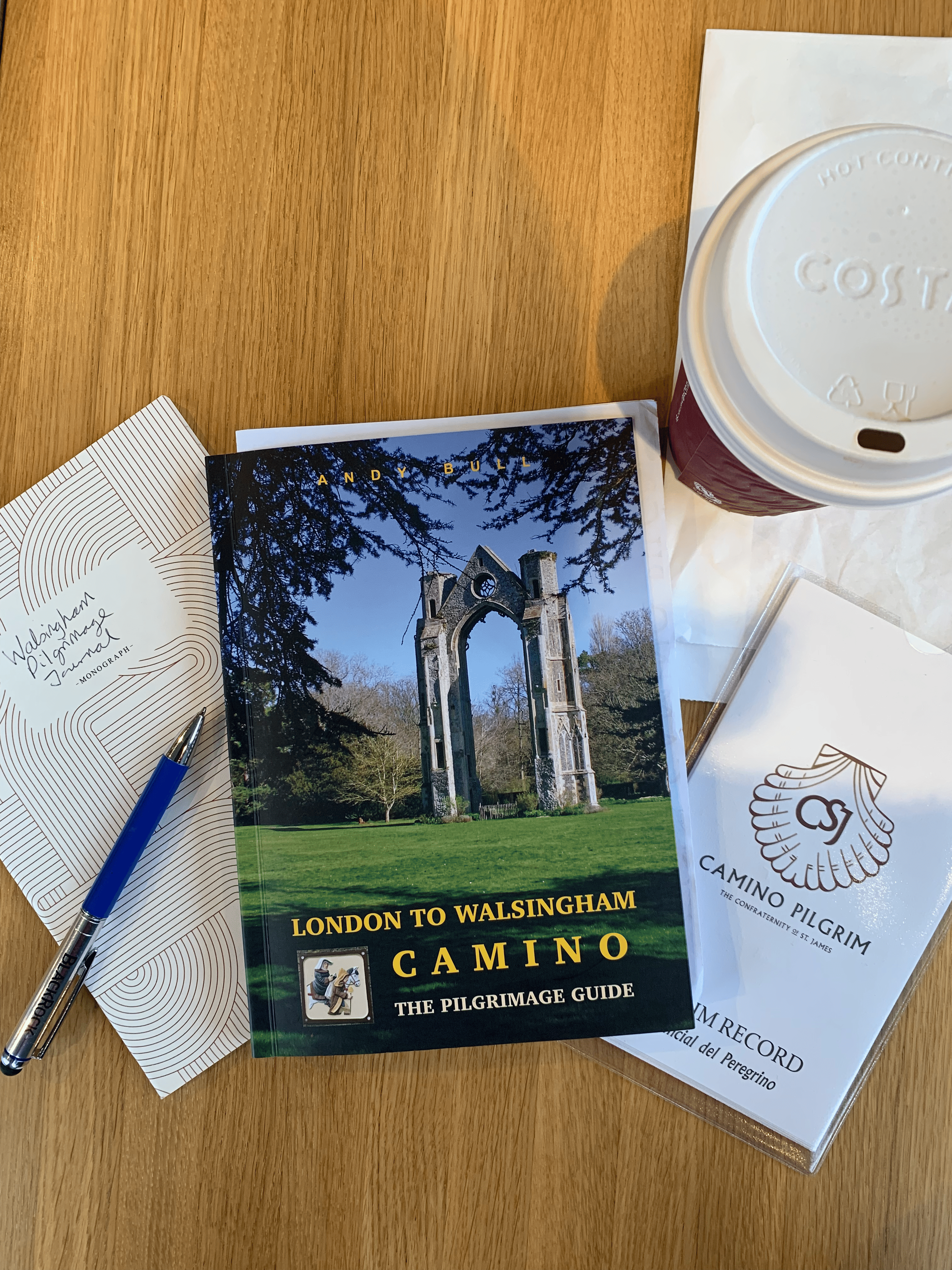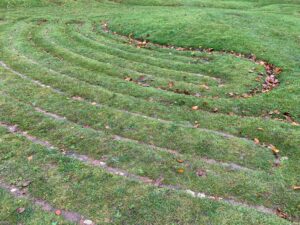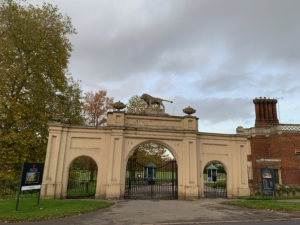London to Walsingham Camino. I saw the book in the gift shop and knew I wanted to do it. Walsingham is one of my favourite places. A sleepy English village buried deep in the north Norfolk countryside, Walsingham hums with a spiritual resonance so gentle you might mistake it for the baa of the sheep in the fields or the burble of the little river. It’s been a place of pilgrimage for centuries, but few people arrive here on foot nowadays.
Like many people, I first visited Walsingham on a coach trip organised by my local church. After a long drive along busy main roads, we turned onto winding, cow-parsley-fringed lanes which seemed too narrow for modern vehicles. The trees were tall, the fields green, the few buildings old brick and flint. Watching the swallows dip and weave overhead, I felt as if we were travelling back in time, descending into a magical place where anything might be possible.

Promise and Prayer
We walked the holy mile from the ancient Slipper Chapel to the ruins of the old Priory. When we reached the site of the Holy House – no more than a wooden plaque in the grass now – our priest said something I have never forgotten. ‘Mary promised to help anyone who comes to pray here, in this place. I’ve always believed that was worth making the trip once a year.’ So I prayed, there in that quiet garden, and yes, my prayer was answered, although it took years and many more tears than I would have chosen. God, I find, has a way of answering prayers like that.
She built it, and they came
According to legend, the Virgin Mary appeared at Walsingham in a vision to the lady of the manor, Richeldis, in 1061. Mary asked Richeldis to build a replica of the house in Nazareth where Mary lived with Joseph and Jesus. As the saying goes, she built it, and they came. The Holy House, as it came to be called, was a small structure built to the dimensions given by the Virgin. It became a place of pilgrimage, with a huge church and Priory growing up around it. Kings, queens, and nobles travelled here from all over Europe, as well as countless ordinary people. Known as ‘England’s Nazareth’, medieval Walsingham was revered as the holiest pilgrimage destination in Europe after Jerusalem, Rome, and Santiago de Compostela. More English pilgrims walked from London to Walsingham than to Canterbury.
King Henry VIII came twice to Walsingham as a pilgrim, the first time to pray for a son, and the second to give thanks for answered prayer. But everything changed after the splitting of the English church from Rome and the subsequent dissolution of the monasteries. On Henry’s authority, the Priory at Walsingham was demolished, the monks scattered, and the Holy House destroyed. Pilgrimages to Walsingham ended for four hundred years, and the village sunk back into rural obscurity.

Shoes and a Cowshed
It wasn’t until the late nineteenth and early twentieth centuries that a modest revival began. It started with a cowshed. There was a little chapel, a mile outside the village, where pilgrims used to leave their shoes in order to walk barefoot to the Holy House. This Slipper Chapel, as it was known, had survived the general destruction but was now in use to house farm animals. Charlotte Boyd re-discovered the Slipper Chapel in 1897 and used her own funds to purchase it for restoration as a place of prayer. For the second time in this story, she built it, and they came.
The Slipper Chapel became the focal point of the Roman Catholic National Shrine of Our Lady. Anglican Christians came too, building a beautiful Shrine Church which contains a replica of the Holy House in the heart of Little Walsingham village. Excavations in the grounds of the old Priory in 1961 unearthed the site of the original Holy House. Walsingham became a place of pilgrimage again, with over a quarter of a million pilgrims now visiting every year[1].

An Impossible Dream?
I’ve visited Walsingham several times since my first parish pilgrimage over twenty years ago. I’ve always travelled by car or coach. The idea of walking there had occurred to me more than once, but it didn’t seem to be a thing that people did. I had even looked at a map and wondered vaguely how long the journey might take, and where one might sleep on the way, but that was about it. I didn’t have the time anyway. As the main carer for my disabled daughter, it’s difficult for me to escape my responsibilities for more than a day or two at best. Taking two weeks off to walk to Walsingham was an impossible dream. I mentally added it to the pile of things I would love to do one day if my life somehow changed.

And then I saw the book ...
And then I saw the book[2]. I was in Walsingham for a brief visit, and there it was, in the shop at the Catholic Shrine. I picked it up, looked at it, turned it over, feeling a frisson of excitement. Someone else had the same idea, and had put it into practice, and written a book about it. Here was a detailed guidebook, with maps, a carefully researched route, suggestions about places to stay and eat. There were even links to gpx files so you could follow the maps on your phone. It existed: a London to Walsingham Camino, newly researched, mapped, and ready to walk.
I put the book down again, telling myself I didn’t have time to do the pilgrimage, that the book would gather dust on a shelf at home. I wandered around the shop, glancing at First Communion cards, rosaries, and mugs with Bible quotes, but the book was calling my name. Buying the book is the first step, said a voice in my head. So I picked it up and took it to the till.
Maybe I could do it in sections, the voice in my head said. Maybe just a day or two at a time. I could use public transport … A plan was forming.
A Walking Pilgrimage
There is something special about a walking pilgrimage. My husband, Adrian, and I walked the last one hundred kilometres of the Camino de Santiago in northern Spain a few years ago. Walking to your destination gives you time to reflect, to meet other pilgrims, to discover the surprises and the dullness of the road, to get sore feet. The walk, like life, may be difficult at times. It may be lonely, or tedious, or just plain painful. But the destination, when you reach it, is a thousand times more wonderful because of all you have been through to get there. When, after a week of tramping through the countryside, we walked into the city of Santiago de Compostela with its vast cathedral and extravagantly beautiful buildings, I felt as if I was entering heaven. This must be how the medieval pilgrims felt, I thought.
An adventure begins
Once I brought the book home, I couldn’t ignore it. The painstakingly researched London to Walsingham Camino is almost one hundred and eighty miles long, divided into thirteen suggested daily stages. I knew I couldn’t take two weeks off to walk it in one go, but I wasn’t going to let that stop me.
Adrian and I take turns to give each other a weekend off, once a month or so, while the other cares for our daughter, Martha, who has Down Syndrome. I decided to use some of my free weekends to walk from London to Walsingham. It might take me a year or more to cover the distance, and getting to the start and end of each stage might prove challenging once I reached the more rural parts of East Anglia, but I would do it anyway. It would be an adventure. Once I started, I would find a way to keep going. I was going to walk to Walsingham.

[1] You can read more here about the history of Walsingham
https://aleteia.org/2018/05/08/englands-only-approved-marian-apparition-gives-us-a-peek-at-nazareth/
[2] The book is called London to Walsingham Camino – The Pilgrimage Guide, written by Andy Bull and published by Trailblazer Guides in 2022. I highly recommend it.
You can purchase the book from Amazon here




